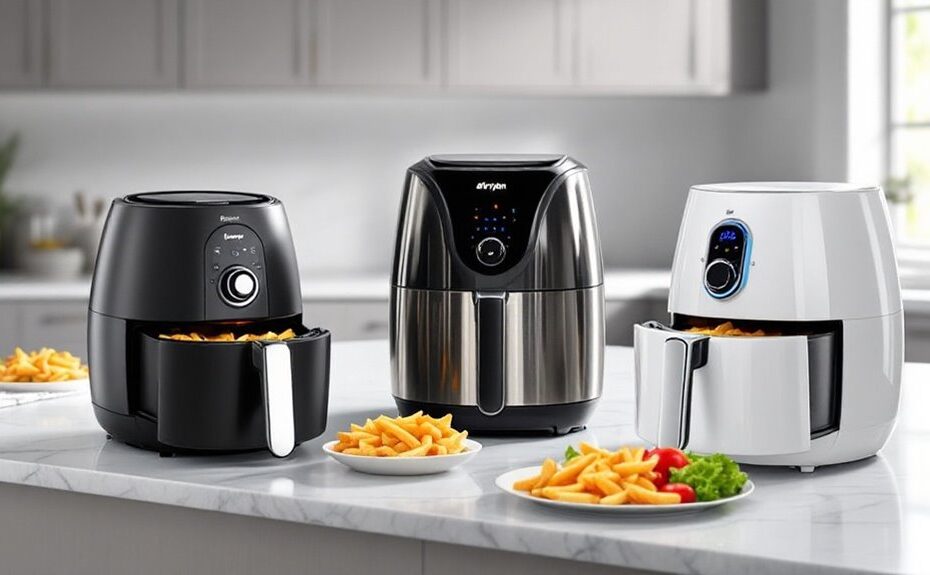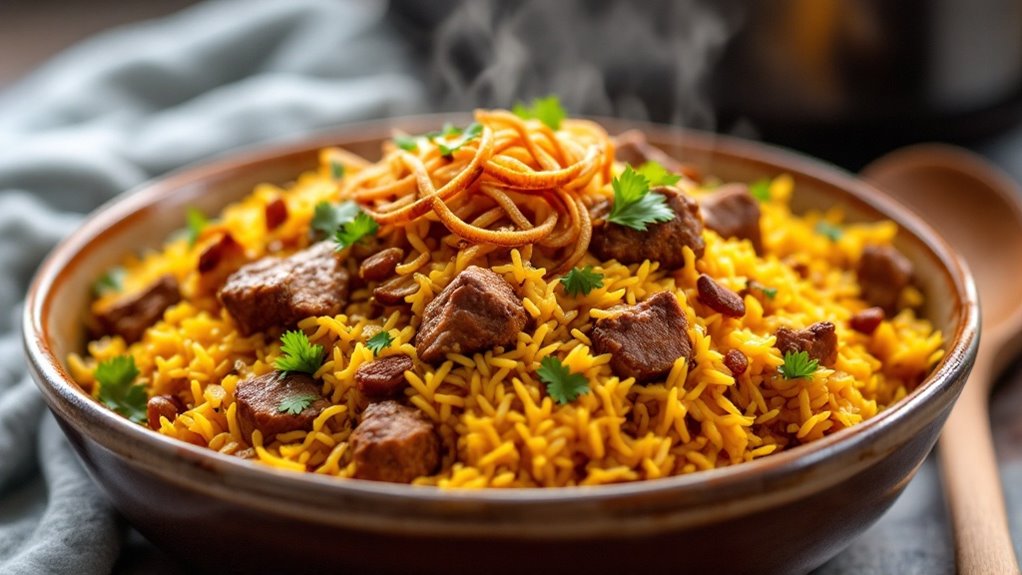Choosing the best air fryer starts with understanding your cooking habits and household size. You'll need to balance capacity, wattage, and features like temperature control or preset programs to match your needs. But how do you decide which model offers the right mix of durability, ease of cleaning, and energy efficiency? With so many options available, it's easy to feel overwhelmed. What if the perfect air fryer is just one overlooked detail away? Stay tuned to uncover the key factors that'll help you make a confident choice without breaking the bank.
Key Takeaways
- Assess household size and meal portions to determine the ideal air fryer capacity (2-8 quarts).
- Prioritize models with precise temperature control and preset programs for versatile cooking.
- Choose a design that fits your countertop space and ensures easy cleaning with removable, non-stick parts.
- Opt for energy-efficient models (1400-1600 watts) to balance performance and power consumption.
- Compare prices, read user reviews, and prioritize brands with strong reputations for durability and customer support.
Determine Your Cooking Capacity Needs
When choosing an air fryer, the first step is to assess your cooking capacity needs based on your household size and typical meal portions. For smaller households or individuals, a compact 2- to 3-quart model suffices for single-serving meals or light snacks. However, if you're preparing family meals or larger portion sizes, opt for a 5- to 6-quart capacity to accommodate multiple servings or bulk cooking. Larger families may even consider 8-quart models for versatility. Keep in mind that overloading the basket reduces efficiency, so choose a size that aligns with your daily cooking habits. Compare models by their usable space, as some designs waste capacity with bulky trays. Prioritizing capacity guarantees your air fryer meets your needs without compromising performance.
Evaluate Available Cooking Functions
While air fryers are primarily known for their ability to fry with little to no oil, many models now offer a range of cooking functions that expand their versatility. Look for units with precise temperature control, allowing you to adjust heat settings in small increments for the best possible results. Preset programs are another key feature, simplifying tasks like baking, roasting, or dehydrating with one-touch convenience. Compare models to see which offer the most useful presets for your cooking habits. Some air fryers even include specialized functions like reheating or rotisserie, broadening their utility. Make sure the cooking functions align with your needs—whether you're preparing crispy fries or slow-roasting vegetables. A model with multiple functions can replace several kitchen appliances, saving space and streamlining your cooking process.
Consider the Size and Design
When choosing an air fryer, assess its capacity to guarantee it meets your household's needs while fitting comfortably on your countertop. Compare the shape and layout—basket-style models are compact but may limit capacity, while oven-style designs offer more space but require extra room. Prioritize durable materials like stainless steel or BPA-free plastics for longevity and ease of cleaning.
Capacity and Space
Since air fryers come in various sizes, it's essential to evaluate your household's requirements and available kitchen space before making a purchase. Assess your countertop space to guarantee the appliance fits comfortably without overcrowding your kitchen. Compact models with smaller storage sizes suit individuals or small families, while larger units with capacities of 5-6 quarts accommodate bigger households. Compare the dimensions and weight of different models to determine if they align with your storage size needs, especially if you plan to stow the air fryer when not in use. Larger capacities often mean bulkier designs, so balance functionality with practicality. Prioritize models that maximize cooking space without sacrificing ease of use or requiring excessive countertop space.
Shape and Layout
The shape and layout of an air fryer greatly impact its functionality and how it fits into your kitchen workflow. A compact design is ideal for smaller kitchens or limited counter space, as it maximizes efficiency without sacrificing performance. Vertical layouts, where the basket stacks above the heating element, often save more space than horizontal designs. However, vertical models may require more clearance above the unit for proper ventilation. Consider how the air fryer's shape aligns with your storage needs—some models have detachable parts for easier stacking. Additionally, a well-designed layout guarantees even heat distribution and easier access to the basket. Compare models to find one that balances space-saving features with usability, making certain it complements your kitchen setup without disrupting your cooking routine.
Material and Durability
While choosing an air fryer, the material and durability are critical factors that directly influence its longevity and performance. Look for models made from high-quality, food-grade materials like stainless steel or BPA-free plastic to guarantee material safety. Stainless steel offers superior durability and heat resistance, while BPA-free plastics are lightweight and easier to clean. Pay attention to the build quality, especially for the basket and heating elements, as these endure the most wear. A sturdy, well-constructed air fryer resists warping and maintains consistent cooking temperatures. Compare models with reinforced handles and non-slip bases for added stability. Investing in a durable air fryer with excellent build quality assures it withstands frequent use, saving you money and hassle in the long run. Prioritize materials that balance safety, durability, and ease of maintenance.
Check Ease of Cleaning Features
Look for air fryers with removable parts like baskets and trays, as they simplify cleaning and reduce effort. A high-quality non-stick coating prevents food from sticking, making scrubbing unnecessary and extending the appliance's lifespan. Dishwasher-safe components save time, but verify their durability to guarantee they withstand repeated washing cycles.
Removable Parts Design
When selecting an air fryer, removable parts design plays a pivotal role in guaranteeing hassle-free maintenance. Look for a removable basket design that allows you to easily detach the cooking chamber for cleaning. Models with detachable tray options, such as drip trays or racks, simplify grease removal and prevent residue buildup. Compare designs—some baskets feature handles for safer handling, while others include dishwasher-safe components for added convenience. Make sure the parts fit securely during use but detach effortlessly for cleaning. Avoid overly complex designs with multiple small pieces, as they can complicate maintenance. Prioritize air fryers with smooth edges and minimal crevices to reduce food trapping. A well-thought-out removable parts design not only enhances cleaning efficiency but also extends the appliance's lifespan.
Non-Stick Coating Quality
The quality of a non-stick coating directly impacts how easily you can clean your air fryer after use. Look for coatings made from non-toxic materials, such as ceramic or PFOA-free PTFE, which guarantee safer cooking and easier maintenance. Coating durability is vital; thicker, multi-layered coatings resist scratches and wear better than single-layer options, extending the fryer's lifespan. Compare models by checking if the coating is reinforced with materials like diamond or titanium, which enhance scratch resistance. Avoid abrasive tools when cleaning to preserve the coating's integrity. While some coatings claim to be non-stick, lower-quality options may degrade over time, leading to stuck-on food and harder cleanup. Prioritize brands with proven track records for durable, non-toxic coatings to balance performance and safety.
Dishwasher-Safe Components
If you're aiming for hassle-free cleanup, dishwasher-safe components can substantially simplify maintaining your air fryer. Look for models with dishwasher safe baskets and trays, as these parts often accumulate grease and food residue. Not all air fryers offer this feature, so prioritize brands that explicitly state their components are dishwasher-safe. Stainless steel or high-quality non-stick coatings typically withstand dishwasher cycles better, ensuring durability over time. Compare models to see if the entire basket or just the tray is dishwasher-safe, as this affects convenience. While some air fryers claim to be dishwasher-safe, verify their compatibility with your dishwasher's settings to avoid warping or damage. Investing in dishwasher-safe components saves time and effort, making post-cooking cleanup seamless and efficient.
Compare Energy Efficiency and Power
Air fryers generally consume less energy compared to traditional ovens, making them a more efficient option for smaller cooking tasks. When comparing energy consumption, air fryers typically operate between 800 and 1800 watts, while conventional ovens can use 2000 to 5000 watts. This wattage comparison highlights their efficiency, especially for quick meals or reheating. Higher-wattage models heat up faster and cook food more evenly, but they also draw more power. If energy efficiency is a priority, opt for a mid-range wattage model (around 1400-1600 watts) that balances performance and power usage. Additionally, air fryers' compact size reduces preheating time, further lowering energy consumption. Always check the wattage specifications to guarantee the appliance aligns with your energy-saving goals without compromising cooking performance.
Set a Realistic Budget
When considering energy efficiency and power, it's also important to factor in cost. Air fryers vary widely in price range, from budget-friendly models under $50 to premium options exceeding $200. Start by determining your budget planning based on how often you'll use the appliance and the features you need. Entry-level models often lack advanced settings but still deliver solid performance for basic cooking. Mid-range options, typically between $80 and $150, offer better build quality, larger capacities, and more precise temperature controls. High-end models include smart features and sleek designs but may not justify the cost if you're a casual user. Compare prices across retailers and consider long-term savings from energy-efficient models. Setting a realistic budget guarantees you get the best value without overspending.
Read Reviews and Compare Brands
Before making a purchase, it's essential to research and compare brands to guarantee you're investing in a reliable air fryer. Start by conducting a user feedback analysis on platforms like Amazon, Best Buy, or dedicated review sites. Look for recurring themes in reviews, such as durability, ease of cleaning, and cooking performance. Pay attention to both positive and negative comments to identify potential issues. Next, perform a brand reputation comparison by evaluating established names like Philips, Ninja, and Cosori against newer entrants. Established brands often offer better warranties and customer support, while newer brands might provide innovative features at lower prices. Prioritize brands with consistent high ratings and proven track records to confirm your air fryer meets expectations and lasts for years.
Disclosure: As an Amazon Associate, I earn from qualifying purchases.



